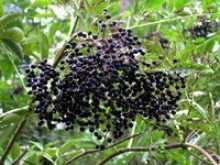This has been a prime year for home canning and preservation - aside from anecdotal evidence (everyone I know is canning stuff), I recently read that the sales of Ball glass mason jars is up 30% this year over last! Now that the growing season is coming to an end, the transition into fall has brought a predictable transition in food preservation as well. It's time to make fruit wine!
Elderberry and blackberry wine are the fruit wines most people are familiar with. But you can make fruit wine out of any fruit (literally any - there is a winery in Hawaii which is famous for producing pineapple wine). Traditionally the softer fruits like cherries and plums tended to be made into fruit wines more often, because it was the best way to preserve these tender fruits in the era before freezers and electricity were invented.
By the way, it is legal to make your own wine at home in America. In 1978 the US Government legalized home winemaking, with volume restrictions. A household with one adult may produce up to 100 gallons of wine per year. A household with two adults may produce up to 200 gallons per year. Obviously you are not allowed to sell the wine, or to give it to underage minors.
(The difference between wine and moonshine is that wine and beer are fermented homemade alcoholic beverages. Moonshine and its ilk are distilled homemade alcoholic beverages. Winemaking and homebrewing beer is okay. Distilling alcoholic beverages using a still? Not okay.)
Fruit wine has a lesser reputation compared to "real wine," partly because we have become a culture of wine snobs. This SF Gate article on fruit wines refers to "grandpa's wine." But it must be admitted that fruit wine tends to be sticky sweet, and can have a distinctive cough syrup overtones. Many home winemakers drink their wines more like a port or a sherry - in a small glass, as an aperitif or an after-meal dessert.
To make your own fruit wine, you will need a lot (a LOT) of fruit, a fair amount of sugar (2-5 pounds), a sterile container (this can be a plastic bucket) for the first fermentation, a serious container like a carboy with a fermentation lock for the second fermentation, and (eventually) wine bottles and corks.
The basic process is:
1. Cook down all of the ingredients on the stovetop into a syrup.
2. Pour into the first sterile container, for the first fermentation, until most of the major bubbling has subsided. This process takes a few days.
3. Strain it and decant into a carboy with a fermentation lock and set it somewhere dark for the second fermentation. This takes six months to a year.
4. Once it's finished, pour the wine into bottles and cork them (this is called "racking").
The Herbwife's Kitchen has a basic overview of her elderberry wine recipe, which is a great overview of the home fruit wine-making process. Jack Keller's winemaking website is one of the better in-depth internet resources for home winemaking (scroll down past all the bits and bobs on the main page to get to the meaty content).
Elderberry and blackberry wine are the fruit wines most people are familiar with. But you can make fruit wine out of any fruit (literally any - there is a winery in Hawaii which is famous for producing pineapple wine). Traditionally the softer fruits like cherries and plums tended to be made into fruit wines more often, because it was the best way to preserve these tender fruits in the era before freezers and electricity were invented.
By the way, it is legal to make your own wine at home in America. In 1978 the US Government legalized home winemaking, with volume restrictions. A household with one adult may produce up to 100 gallons of wine per year. A household with two adults may produce up to 200 gallons per year. Obviously you are not allowed to sell the wine, or to give it to underage minors.
(The difference between wine and moonshine is that wine and beer are fermented homemade alcoholic beverages. Moonshine and its ilk are distilled homemade alcoholic beverages. Winemaking and homebrewing beer is okay. Distilling alcoholic beverages using a still? Not okay.)
Fruit wine has a lesser reputation compared to "real wine," partly because we have become a culture of wine snobs. This SF Gate article on fruit wines refers to "grandpa's wine." But it must be admitted that fruit wine tends to be sticky sweet, and can have a distinctive cough syrup overtones. Many home winemakers drink their wines more like a port or a sherry - in a small glass, as an aperitif or an after-meal dessert.
To make your own fruit wine, you will need a lot (a LOT) of fruit, a fair amount of sugar (2-5 pounds), a sterile container (this can be a plastic bucket) for the first fermentation, a serious container like a carboy with a fermentation lock for the second fermentation, and (eventually) wine bottles and corks.
The basic process is:
1. Cook down all of the ingredients on the stovetop into a syrup.
2. Pour into the first sterile container, for the first fermentation, until most of the major bubbling has subsided. This process takes a few days.
3. Strain it and decant into a carboy with a fermentation lock and set it somewhere dark for the second fermentation. This takes six months to a year.
4. Once it's finished, pour the wine into bottles and cork them (this is called "racking").
The Herbwife's Kitchen has a basic overview of her elderberry wine recipe, which is a great overview of the home fruit wine-making process. Jack Keller's winemaking website is one of the better in-depth internet resources for home winemaking (scroll down past all the bits and bobs on the main page to get to the meaty content).
